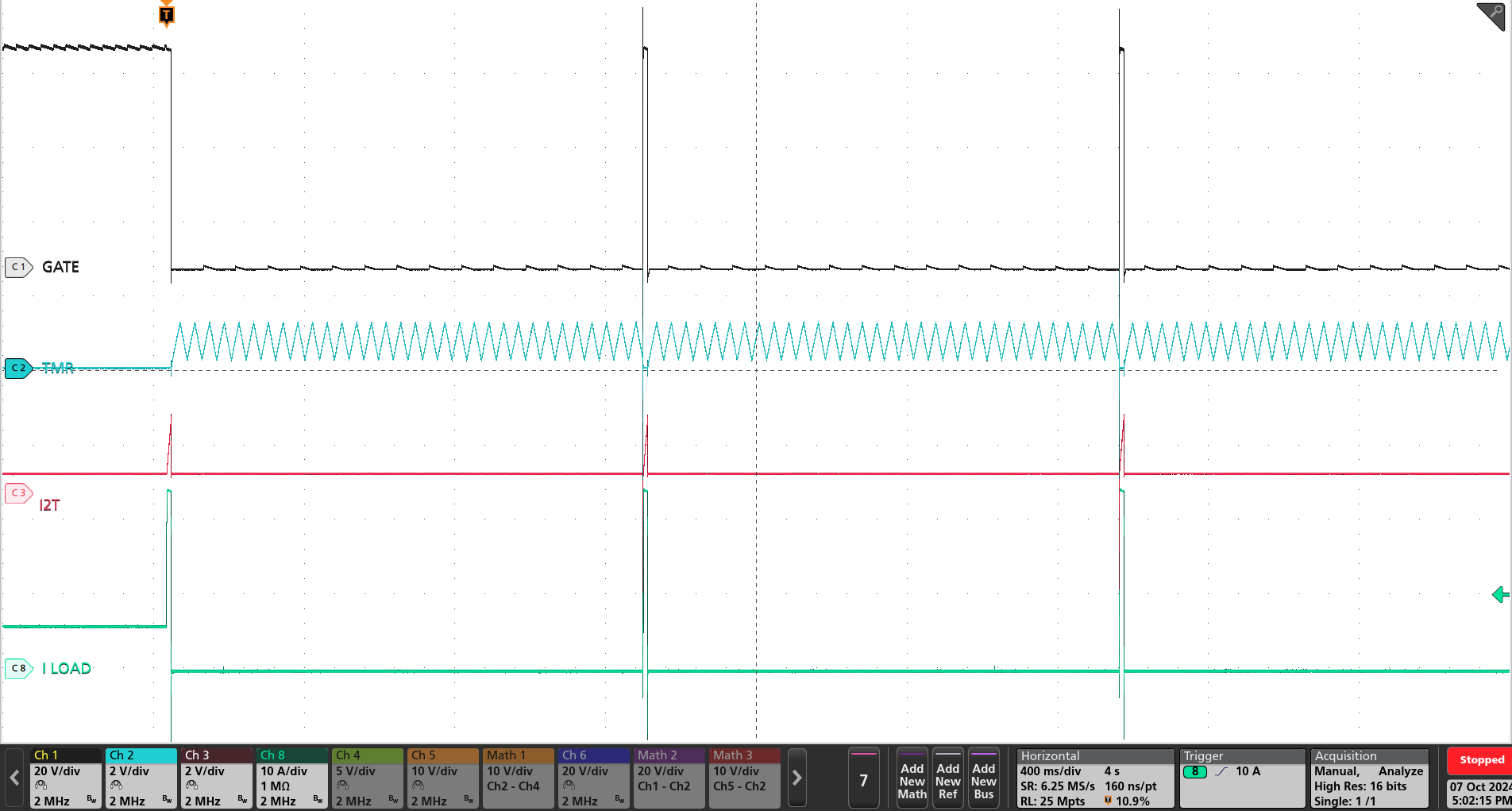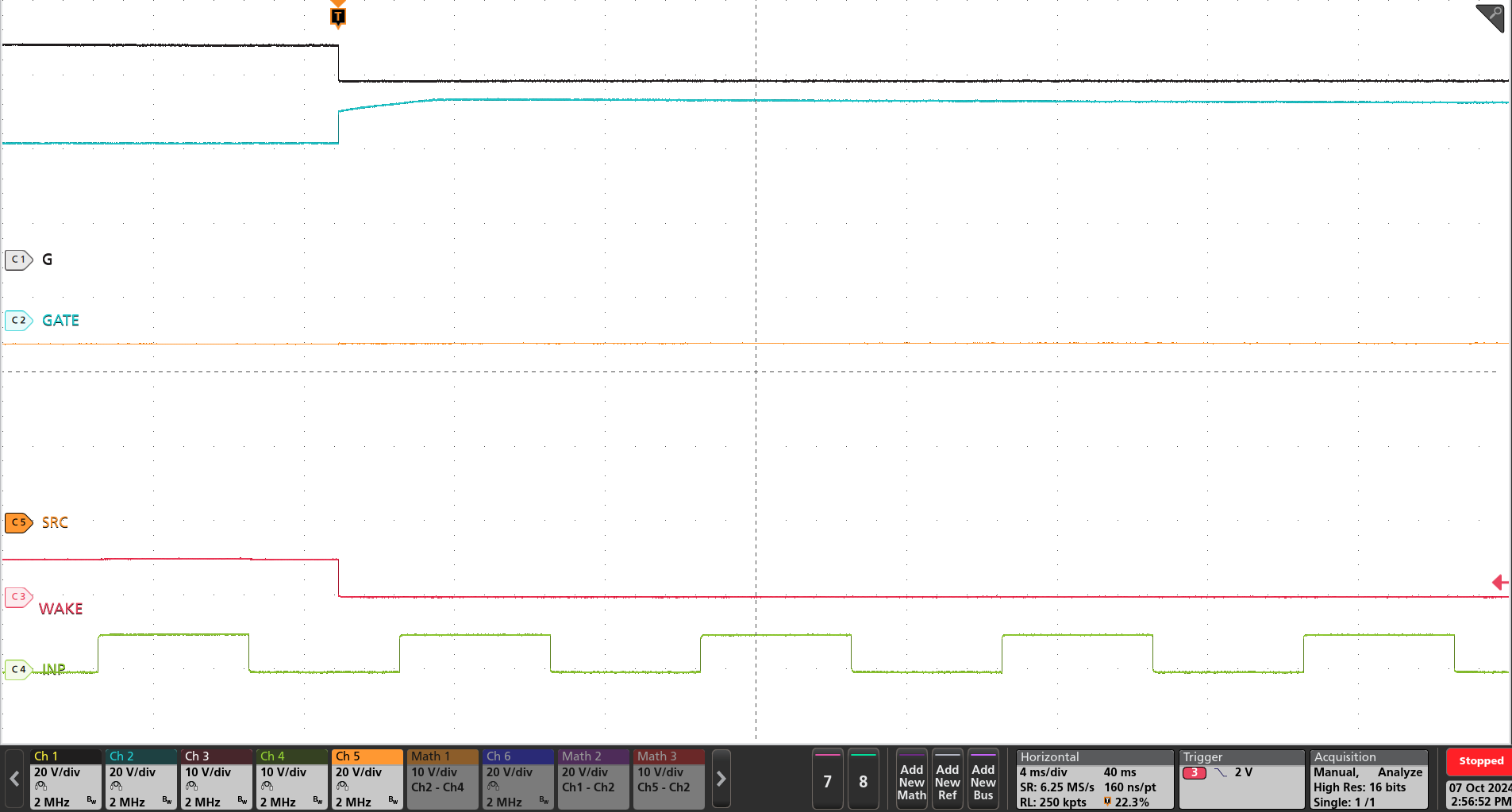SLUSFM1 December 2024 TPS4812-Q1
PRODUCTION DATA
- 1
- 1 Features
- 2 Applications
- 3 Description
- 4 Device Comparison
- 5 Pin Configuration and Functions
- 6 Specifications
- 7 Parameter Measurement Information
-
8 Detailed Description
- 8.1 Overview
- 8.2 Functional Block Diagram
- 8.3
Feature Description
- 8.3.1 Charge Pump and Gate Driver Output (VS, GATE, BST, SRC)
- 8.3.2 Capacitive Load Driving
- 8.3.3 Overcurrent and Short-Circuit Protection
- 8.3.4 Analog Current Monitor Output (IMON)
- 8.3.5 NTC-Based Temperature Sensing (TMP) and Analog Monitor Output (ITMPO)
- 8.3.6 Fault Indication and Diagnosis (FLT)
- 8.3.7 Reverse Polarity Protection
- 8.3.8 Undervoltage Protection (UVLO)
- 8.4 Device Functional Modes
- 9 Application and Implementation
- 10Device and Documentation Support
- 11Revision History
- 12Mechanical, Packaging, and Orderable Information
パッケージ・オプション
デバイスごとのパッケージ図は、PDF版データシートをご参照ください。
メカニカル・データ(パッケージ|ピン)
- RGE|23
サーマルパッド・メカニカル・データ
発注情報
9.2.3 Application Curves
 Figure 9-2 Start-Up Profile of Low Power Path (LPM = Low, VIN = 48V, No Load, CBST = 470nF)
Figure 9-2 Start-Up Profile of Low Power Path (LPM = Low, VIN = 48V, No Load, CBST = 470nF) Figure 9-4 Zoom-In View of State Transition From LPM to Active Mode (LPM = Low, VIN = 48V, EN/UVLO = High)
Figure 9-4 Zoom-In View of State Transition From LPM to Active Mode (LPM = Low, VIN = 48V, EN/UVLO = High) Figure 9-6 State Transition From LPM to Active Mode (LPM = Low to High, VIN = 48V, No Load)
Figure 9-6 State Transition From LPM to Active Mode (LPM = Low to High, VIN = 48V, No Load) Figure 9-8 I2T based Overcurrent Response of TPS4812-Q1 EVM for 6A to 16A Load Step
Figure 9-8 I2T based Overcurrent Response of TPS4812-Q1 EVM for 6A to 16A Load Step Figure 9-10 Auto-Retry Response of TPS4812-Q1 for an I2T-Based Overcurrent Fault
Figure 9-10 Auto-Retry Response of TPS4812-Q1 for an I2T-Based Overcurrent Fault Figure 9-12 Output Short-Circuit Response of TPS4812-Q1
Figure 9-12 Output Short-Circuit Response of TPS4812-Q1 Figure 9-14 TPS4812-Q1 Bi-directional Current Monitoring Output (IMON, I_DIR) Transient Response
Figure 9-14 TPS4812-Q1 Bi-directional Current Monitoring Output (IMON, I_DIR) Transient Response Figure 9-3 State Transition From LPM to Active Mode (LPM = Low, VIN = 48V, EN/UVLO = High)
Figure 9-3 State Transition From LPM to Active Mode (LPM = Low, VIN = 48V, EN/UVLO = High) Figure 9-5 When LPM = Low in LOAD WAKEUP state, INP Has No Control on GATE
Figure 9-5 When LPM = Low in LOAD WAKEUP state, INP Has No Control on GATE Figure 9-7 With LPM = Low to High, INP Gained Control on GATE (VIN = 48V, No Load)
Figure 9-7 With LPM = Low to High, INP Gained Control on GATE (VIN = 48V, No Load) Figure 9-9 I2T based Overcurrent Response of TPS4812-Q1 EVM for 6A to 23A Load Step
Figure 9-9 I2T based Overcurrent Response of TPS4812-Q1 EVM for 6A to 23A Load Step Figure 9-11 Latch-Off Response of TPS4812-Q1 for an I2T-Based Overcurrent Fault
Figure 9-11 Latch-Off Response of TPS4812-Q1 for an I2T-Based Overcurrent Fault Figure 9-13 TPS4812-Q1 Current Monitoring Output (IMON) Transient Response
Figure 9-13 TPS4812-Q1 Current Monitoring Output (IMON) Transient Response Figure 9-15 GATE Turn-OFF During Input Reverse Battery Fault
Figure 9-15 GATE Turn-OFF During Input Reverse Battery Fault